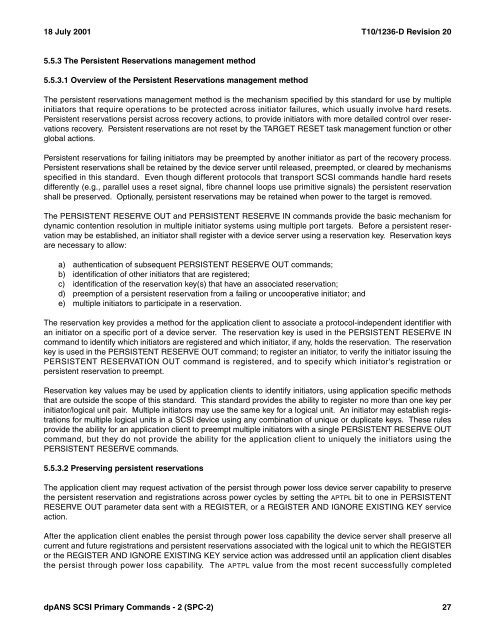SCSI Primary Commands - 2.pdf
SCSI Primary Commands - 2.pdf
SCSI Primary Commands - 2.pdf
- No tags were found...
Create successful ePaper yourself
Turn your PDF publications into a flip-book with our unique Google optimized e-Paper software.
18 July 2001 T10/1236-D Revision 205.5.3 The Persistent Reservations management method5.5.3.1 Overview of the Persistent Reservations management methodThe persistent reservations management method is the mechanism specified by this standard for use by multipleinitiators that require operations to be protected across initiator failures, which usually involve hard resets.Persistent reservations persist across recovery actions, to provide initiators with more detailed control over reservationsrecovery. Persistent reservations are not reset by the TARGET RESET task management function or otherglobal actions.Persistent reservations for failing initiators may be preempted by another initiator as part of the recovery process.Persistent reservations shall be retained by the device server until released, preempted, or cleared by mechanismsspecified in this standard. Even though different protocols that transport <strong>SCSI</strong> commands handle hard resetsdifferently (e.g., parallel uses a reset signal, fibre channel loops use primitive signals) the persistent reservationshall be preserved. Optionally, persistent reservations may be retained when power to the target is removed.The PERSISTENT RESERVE OUT and PERSISTENT RESERVE IN commands provide the basic mechanism fordynamic contention resolution in multiple initiator systems using multiple port targets. Before a persistent reservationmay be established, an initiator shall register with a device server using a reservation key. Reservation keysare necessary to allow:a) authentication of subsequent PERSISTENT RESERVE OUT commands;b) identification of other initiators that are registered;c) identification of the reservation key(s) that have an associated reservation;d) preemption of a persistent reservation from a failing or uncooperative initiator; ande) multiple initiators to participate in a reservation.The reservation key provides a method for the application client to associate a protocol-independent identifier withan initiator on a specific port of a device server. The reservation key is used in the PERSISTENT RESERVE INcommand to identify which initiators are registered and which initiator, if any, holds the reservation. The reservationkey is used in the PERSISTENT RESERVE OUT command; to register an initiator, to verify the initiator issuing thePERSISTENT RESERVATION OUT command is registered, and to specify which initiator’s registration orpersistent reservation to preempt.Reservation key values may be used by application clients to identify initiators, using application specific methodsthat are outside the scope of this standard. This standard provides the ability to register no more than one key perinitiator/logical unit pair. Multiple initiators may use the same key for a logical unit. An initiator may establish registrationsfor multiple logical units in a <strong>SCSI</strong> device using any combination of unique or duplicate keys. These rulesprovide the ability for an application client to preempt multiple initiators with a single PERSISTENT RESERVE OUTcommand, but they do not provide the ability for the application client to uniquely the initiators using thePERSISTENT RESERVE commands.5.5.3.2 Preserving persistent reservationsThe application client may request activation of the persist through power loss device server capability to preservethe persistent reservation and registrations across power cycles by setting the APTPL bit to one in PERSISTENTRESERVE OUT parameter data sent with a REGISTER, or a REGISTER AND IGNORE EXISTING KEY serviceaction.After the application client enables the persist through power loss capability the device server shall preserve allcurrent and future registrations and persistent reservations associated with the logical unit to which the REGISTERor the REGISTER AND IGNORE EXISTING KEY service action was addressed until an application client disablesthe persist through power loss capability. The APTPL value from the most recent successfully completeddpANS <strong>SCSI</strong> <strong>Primary</strong> <strong>Commands</strong> - 2 (SPC-2) 27



![[MS-DFSRH]: DFS Replication Helper Protocol Specification](https://img.yumpu.com/51326226/1/190x245/ms-dfsrh-dfs-replication-helper-protocol-specification.jpg?quality=85)



![[MS-VDS]: Virtual Disk Service (VDS) Protocol Specification](https://img.yumpu.com/50743814/1/190x245/ms-vds-virtual-disk-service-vds-protocol-specification.jpg?quality=85)

![[MS-GPSI]: Group Policy: Software Installation Protocol Extension](https://img.yumpu.com/50703911/1/190x245/ms-gpsi-group-policy-software-installation-protocol-extension.jpg?quality=85)

![[MS-GPPREF]: Group Policy: Preferences Extension Data Structure](https://img.yumpu.com/50206932/1/190x245/ms-gppref-group-policy-preferences-extension-data-structure.jpg?quality=85)





